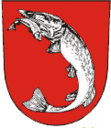Dolní Benešov
| Dolní Benešov | ||||
|---|---|---|---|---|
|
||||
| Basic data | ||||
| State : |
|
|||
| Region : | Moravskoslezský kraj | |||
| District : | Opava | |||
| Area : | 1480 ha | |||
| Geographic location : | 49 ° 55 ' N , 18 ° 6' E | |||
| Height: | 231 m nm | |||
| Residents : | 4,043 (Jan 1, 2019) | |||
| Postal code : | 747 22 | |||
| traffic | ||||
| Street: | Opava - Hlučín | |||
| Railway connection: | Opava - Hlučín | |||
| structure | ||||
| Status: | city | |||
| Districts: | 2 | |||
| administration | ||||
| Mayor : | Martin Štefek (as of 2007) | |||
| Address: | Hájecká ul. 65 747 22 Dolní Benešov |
|||
| Municipality number: | 506702 | |||
| Website : | www.dolnibenesov.cz | |||
Dolní Benešov (formerly also Benešov u Hlučína ; German Benischau, Benischaw, Benischow , 1816-1945 market Benischau, Beneschau ) is a city in the Czech Republic . It is located 17 km northwest of Ostrava and belongs to the Okres Opava .
geography
The city is located in a pond landscape to the left of the oppa in the Hultschiner Ländchen . Southwest of Dolní Benešov are the two largest of the seven fish ponds on the Štěpánka with the two Nezmar ponds. The Opusta flows east of the city and feeds the Chobot, Bobrov, Rakovec, Bezedno and Přehyně ponds. State road 56 from Opava to Ostrava runs through Dolní Benešov .
Neighboring towns are Bohuslavice in the north, Kozmice in the east, Jilešovice in the southeast, Háj ve Slezsku in the south, Smolkov and Lhota in the southwest, Zábřeh in the west and Bolatice and Borová in the northwest.
history
Benischaw was first mentioned in 1312. It belonged to Moravia and was then owned by the Lords of Kravarn , who came from the Benis family ( Páni z Benisova, Benisovici ). In 1371 it came to the dynasty of the Lords of Drahotuš, who had to sell their Drahotuš castle near Mährisch Weißkirchen to the margrave Johann Heinrich . In 1493, Benishaw was raised to the rank of city by King Vladislav II . At the same time it was given the privilege of having a year and a weekly market. After the extinction of the Drahotuš dynasty, Benischaw came in 1594 to their related lords Schipa von Branitz ( Šípa z Branice ) and at the end of the 16th century to the Mošov. Jan Mošovský von Mošov became sub-chamberlain of Moravia in 1602 and campaigned for re-Catholicization. The fortress, which was built in the 14th century, was converted into a Renaissance castle around this time. The villages Bohuslavice, Kozmice and Závada belonged to the Benischau dominion. In 1710 the barons of Kalckreuth bought Benischow, followed by the Counts of Henneberg in 1774 .
After the First Silesian War in 1742, Benischow fell to Prussia , with Oppa forming the border with Austrian Silesia . After the reorganization of Prussia, it belonged to the province of Silesia from 1815 and was incorporated into the district of Ratibor from 1816–1945 . At the same time it lost its town charter and was downgraded to a town or market .
In 1846 the Rothschild bought Benischau. In 1848 the town and the castle were occupied by insurgents and held for a few days. In 1874 the administrative district Beneschau was formed, to which, in addition to the rural community Beneschau, the Städtel Benischau and the rural communities Kosmütz and Zabrzeh ( Zábřeh ) as well as the manor districts Benischau, Kosmütz ( Kozmice ) and Zabrzeh belonged, in 1885 the market Beneschau had 1772 inhabitants. As a result of the Treaty of Versailles , it came to Czechoslovakia, founded in 1918, in January 1920 . In 1930 there were 1974 people living in Beneschau. After the Munich Agreement , it was reintegrated into the German Reich in 1938. After the Second World War , Dolní Benešov came back to Czechoslovakia in 1945. In 1996 it was given city rights again.
Local division
The district Zábřeh ( Zabrzeh ), 1910–1945 Oppau belongs to Dolní Benešov .
Town twinning
- Santa Maria del Cedro , Italy
- Rájecké Teplice , Slovakia
- Wilamowice , Poland
Attractions
- Dolní Benešov Castle with an English landscape park
- Parish church of St. Martin, built in 1474, rebuilt in 1747 and expanded to include a tower in 1860
- Chapel of the Holy Cross, neo-Gothic brick building, built in 1870 by the Bremen builder F. Exner
- Baroque statue of Immaculata, erected in 1784
- Natural monument NPR Zábřežské louky (Oppauer meadows) with 15 hectares, placed under protection in 1973
sons and daughters of the town
- Cyprián Lelek (1812–1883), priest and journalist, member of the Frankfurt National Assembly
- Vilém Balarin (1894–1978), painter, born in the district of Zábřeh ( Oppau )
- Evžen Hadamczik (1934–1984), football player and coach


